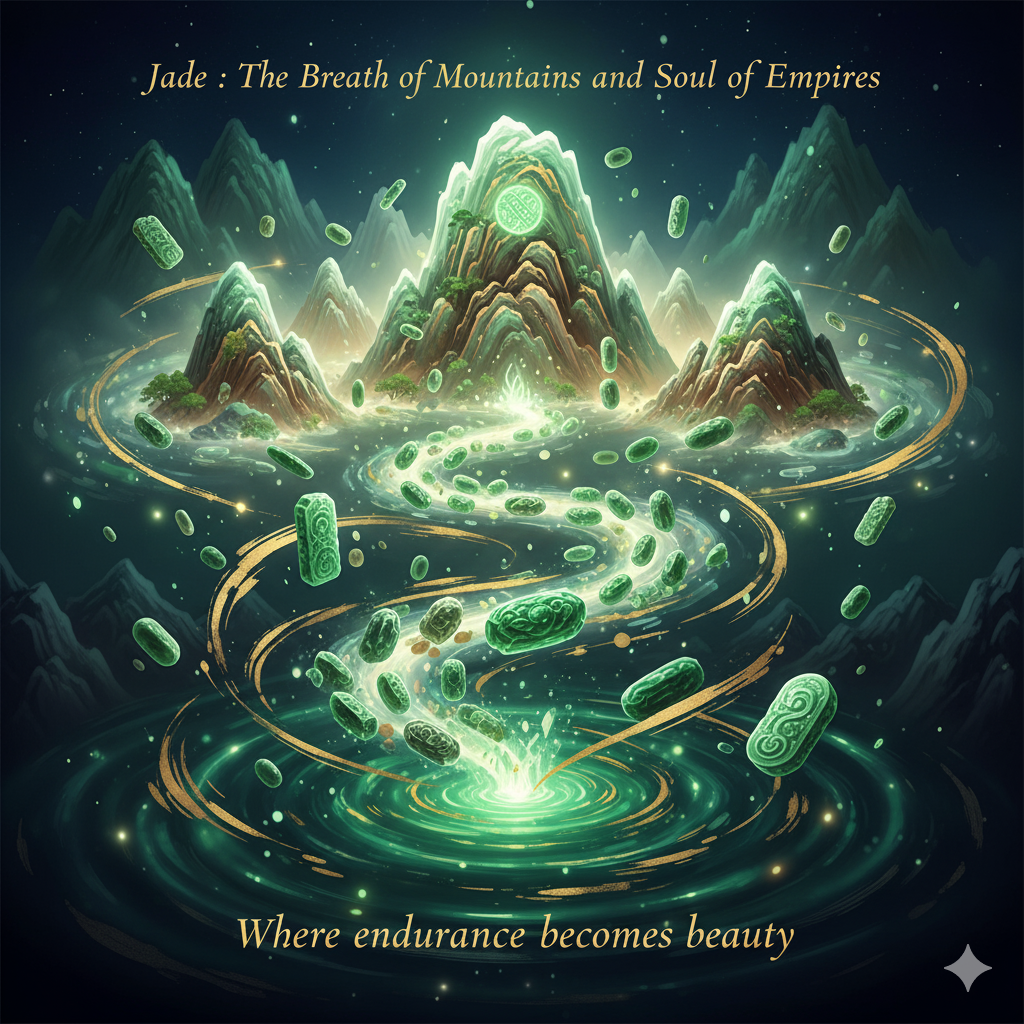Jade: The Breath of Mountains and the Soul of Empires
Where endurance becomes beauty.
1. The Stone that Outlived Kings
Across thousands of years, jade has remained a paradox: tougher than steel, yet soft to the touch; born from rock, yet alive with spirit.
In China, it is yu — the imperial stone, believed to embody virtue itself.
In Central America, it was the breath of gods, the colour of life and death.
No other mineral carries such reverence, poetry, and continuity.
While diamonds symbolize wealth and sapphires nobility, jade symbolizes character — patience, strength, compassion, and immortality.
To the Chinese, gold is valuable. Jade is invaluable.
2. What Is Jade, scientifically?
Unlike most gemstones, “jade” is not a single mineral. It is two distinct rocks united by history and appearance:
| Type | Mineral Composition | Typical Colour | Hardness | Source Regions |
|---|---|---|---|---|
| Jadeite | Sodium aluminum silicate | Green, lavender, white, black | 6.5–7 | Myanmar (Burma), Guatemala, Japan |
| Nephrite | Calcium magnesium silicate | Creamy white, spinach-green, brown | 6–6.5 | China, Russia, Canada, New Zealand |
Both are rich in toughness — a measure of how well a material resists breakage.
Where diamond is hard but brittle, jade is nearly unbreakable — the perfect metaphor for resilience.
3. Jadeite and Nephrite: Cousins in Spirit
Nephrite — The Ancient Jade
Used in China for over 7,000 years, nephrite is the jade of antiquity — creamy, soft green, translucent.
Carved into ritual axes, burial suits, and ornaments, it symbolized protection and the eternal link between heaven and earth.
Jadeite — The Modern Gem Jade
Jadeite entered China only in the 18th century, imported from northern Myanmar’s Kachin State, near Hpakan.
Its electric greens and translucent purity transformed jade from sacred relic to imperial jewel.
The Qing dynasty prized this “Fei Cui” jade — meaning kingfisher green — as the highest form of beauty.
4. The Science of Jade’s Strength
Both jadeite and nephrite have interlocking fibrous microstructures, making them extraordinarily tough.
Even under pressure, the fibers flex rather than crack — a microscopic weave of endurance.
| Property | Jadeite | Nephrite |
|---|---|---|
| Crystal System | Monoclinic | Monoclinic |
| Specific Gravity | 3.3–3.4 | 2.9–3.1 |
| Refractive Index | 1.65–1.67 | 1.61–1.63 |
| Toughness | Exceptional | Superior |
| Transparency | Translucent to opaque | Translucent to opaque |
It is this resilience — not its colour alone — that has made jade synonymous with immortality.
A gentleman should be like jade — gentle in glow, yet unyielding in strength.
5. The Geography of Jade
Myanmar (Burma)
The world’s only source of gem-quality jadeite.
Deposits near Hpakan and Tawmaw yield the legendary Imperial Green — a vivid, pure, chromium-rich hue that glows even in shade.
China
Produces mainly nephrite, historically from Hetian (Khotan) and Lantian.
The pale “mutton fat” nephrite from Hetian is cherished for its waxy, creamy texture and spiritual symbolism.
Other Sources
- Guatemala — Ancient Mayan source of blue-green jadeite.
- Russia (Lake Baikal) — Deep green nephrite with strong translucency.
- New Zealand — Māori pounamu, a sacred nephrite variety, symbolizing ancestry and protection.
- Canada — British Columbia’s nephrite supplies the global decorative jade market.
6. The Spectrum of Jade Colours
| Colour | Description | Type |
|---|---|---|
| Imperial Green | Vibrant, translucent emerald green (chromium) | Jadeite |
| Apple Green | Lively medium tone | Jadeite |
| Lavender Jade | Manganese-based, soothing violet hue | Jadeite |
| Icy White | Colourless and transparent | Jadeite |
| Mutton Fat White | Creamy, waxy, revered in Chinese art | Nephrite |
| Spinach Green | Deep, opaque, iron-rich | Nephrite |
| Black Jade | Dark nephrite with graphite or magnetite | Nephrite |
| Yellow and Orange Jade | Iron-oxide stained, warm tones | Both |
Each tone carries its own emotion — green for vitality, white for purity, lavender for peace, black for protection.
7. The Journey from Rock to Reverence
Mining jade is both physical and spiritual.
In Myanmar, jadeite blocks are extracted from river boulders and metamorphic cliffs, often through backbreaking labour.
Each boulder is tested by cutting small “windows” to reveal inner colour — a process filled with suspense, risk, and intuition.
A single rough boulder can range in value from a few hundred to millions of dollars — depending on the depth of green and translucence revealed beneath its skin.
The journey from mine to market mirrors jade’s meaning itself: patience before perfection.
8. The Grades of Jadeite
Jadeite is classified into three trade types:
| Grade | Treatment | Description |
|---|---|---|
| Type A | Untreated | Natural colour, polished, wax-coated only |
| Type B | Bleached + polymer filled | Bright, artificial translucence, fragile |
| Type C | Dyed | Artificially coloured, unstable |
Type A jadeite is the only form accepted as true jade in fine gem trade — its texture waxy, its lustre luminous, its energy unaltered.
At PreciousCarats, only untreated Type A jadeite — verified by spectroscopic and FTIR testing — is considered worthy of listing.
9. Symbolism and Spiritual Resonance
To the Chinese, jade is not just a stone; it is a moral mirror.
Confucius described jade’s virtues as:
- Warmth — symbolizing benevolence.
- Toughness — representing justice.
- Clarity — denoting wisdom.
- Subtle glow — embodying humility.
In Taoist tradition, jade is believed to bridge heaven and earth, a conductor of balance and protection.
It is also linked with longevity — jade burial suits were crafted for Han emperors so that their bodies would remain pure and eternal.
10. Jade in Ancient Civilizations
China
Jade was used as early as 5000 BCE in Liangzhu culture for ritual discs (bi) and axes (yue).
Every dynasty redefined its meaning — from Shang’s war amulets to Qing’s imperial bangles.
Mesoamerica
The Maya and Olmec carved jadeite into masks, deities, and teeth inlays.
To them, green represented life force — the blood of maize and the breath of gods.
New Zealand
The Māori revered pounamu jade as tribal heirlooms (taonga), passed across generations as symbols of strength and lineage.
Across continents, jade was never just decoration — it was identity.
11. Jade in the Modern World
Today, jade remains a cornerstone of Asian aesthetics and metaphysical belief.
In Hong Kong and Taipei, fine jadeite bangles sell for hundreds of thousands of dollars, while nephrite remains central to traditional Chinese art carving.
Beyond Asia, jade’s spiritual aura has found a global audience in meditation and wellness culture — celebrated for its perceived ability to soothe the mind and align the heart.
12. The Energy of Jade
Metaphysically, jade symbolizes balance, purity, and noble endurance.
It is said to:
- Protect against negativity.
- Harmonize relationships.
- Inspire serenity and courage.
- Enhance prosperity through peace rather than ambition.
In feng shui, jade is placed near doors or worn close to the heart to attract stability and emotional safety.
It is not a stone of luck, but of alignment.
13. The Art of Carving Jade
Carving jade is unlike cutting other gemstones.
Its fibrous texture resists fracture but demands extreme skill.
Master carvers shape jade through slow abrasion with diamond dust, revealing symbolic forms — dragons for power, lotus for purity, peaches for longevity.
A single flawless jade bangle, carved without breakage, may take weeks or months — and if it cracks even slightly, it loses all commercial value but none of its spiritual worth.
14. Market and Value
Fine jadeite competes with ruby and emerald in price.
Auction records reflect its prestige:
- Christie’s Hong Kong, 2014: Jadeite bead necklace — USD 27 million.
- Sotheby’s, 2021: Imperial green bangle — USD 7.5 million.
- Phillips, 2023: Lavender jade suite — USD 1.3 million.
Market values depend on:
- Colour (vividness and uniformity)
- Transparency (misty translucence preferred)
- Texture (smooth, waxy, even grain)
- Treatment (untreated only)
15. Jade, the Emotional Heirloom
Unlike most gems, jade is rarely bought for resale.
It is gifted, inherited, or worn daily — absorbing the life of its wearer.
Over years, contact with skin oils deepens its glow, forming a bond between person and stone.
A jade bangle on a wrist is more than adornment — it is a promise of care, protection, and continuity.
16. PreciousCarats Reflection — The Soul Within the Stone
At PreciousCarats, jade is treated not as inventory, but as testimony — to time, to patience, to grace.
Every piece carries the calm strength of mountains, the warmth of human touch, and the humility of earth refined by eternity.
Some stones glitter. Jade breathes.
It reminds us that endurance is the truest form of beauty.

